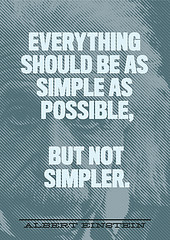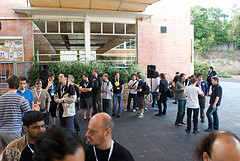|
|
|
Wednesday, August 21st, 2019

Whether you’re talking invention or innovation, it’s important to remember that it’s often the simplicity of a solution, as opposed to complexity, that makes it truly elegant. Along with simplicity, practicality is important, as seen in the MYCOmmunity Toilet, and focusing on plain old common sense can create a viable business by addressing American bias against ugly produce.
Here are a few that actually have world-changing potential.
Following up on yesterday’s idea to re-freeze the Artic is best described as ‘back to the future’.
A California-based company called SkyCool Systems is in the early stages of manufacturing a cooling system that’s more energy efficient than anything humans have used for a century. It’s doing it using radiative cooling, a concept that was used in the Middle East and India hundreds of years ago.
Inventions like this are potential game-changers as the world stares down a growing climate crisis, spurred by emissions pumped into the atmosphere by human activity. Globally, about 12% of non-carbon dioxide emissions can be attributed to refrigeration and air conditioners, according to the US Environmental Protection Agency.
There is a lot of the talk about “food disruption,” mostly focused on new ways to grow food, plant-based protein, etc. But ending food waste would go a long way to feeding the world’s population.
Europe is way ahead of us when it come to reducing food waste.
Nearly 2 million tonnes of food is wasted by the food industry every year in the U.K. alone. Of that waste, 250,000 tonnes is still edible, equating to roughly 650 million meals. When you consider the 8.4 million people in the U.K. struggling to afford to eat, there’s obviously a problem.
And that’s where the Danish-born Too Good To Go app comes in. The app, which is available in 11 countries in Europe, is simple: it connects users to stores, such as supermarkets, restaurants and bakeries, that have unsold, surplus food.
Getting a job when you’ve been in jail is beyond difficult, especially when 40% of the FBI data base is incorrect. Now there’s an app for that. Teresa Hodge and Laurin Leonard came up with a way for companies, landlords, etc., to get more accurate and nuanced background checks.
R3’s software assesses criminal records, as well as credit histories, employment experience and information self-reported by individuals, and produces a numeric indicator for each individual predicting future trends. Scores run from 300 to 850, to mimic the standard framework for conventional credit histories. The higher the number, the less risky the person.
Finally, on the lighter side, innovation women will really appreciate — convenient and safe.
Gina Périer and Alexander Egebjerg have designed an industrial-standard female toilet for festivals and outdoor events that allows people to pee sitting down quickly and safely.
Named Lapee, the pink plastic structure has three urinals arranged in a spiral, with curving back rests that provide privacy while allowing the user to remain aware of their surroundings.
All of these, even Lapee, have the potential to create major change in our world.
Image credit: Fritz Ahlefeldt (Hiking Artist)
Posted in Change, Entrepreneurs, Innovation | No Comments »
Friday, February 23rd, 2018

A Friday series exploring Startups and the people who make them go. Read all If the Shoe Fits posts here.
If I have to listen/read one more time about value/importance/etc of hiring “stars” or the “best” whatever I think I may scream. Or, better yet, shove the words/premise down the appropriate throat.
While I, and a small minority, have tried to debunk this mindset we haven’t made much progress.
So here’s an article from Scott E Page, the Leonid Hurwicz collegiate professor of complex systems, political science and economics at the University of Michigan, Ann Arbor.
Perhaps you’ll pay attention to him.
Why hiring the ‘best’ people produces the least creative results
While in graduate school in mathematics at the University of Wisconsin-Madison, I took a logic course from David Griffeath. The class was fun. Griffeath brought a playfulness and openness to problems. Much to my delight, about a decade later, I ran into him at a conference on traffic models. During a presentation on computational models of traffic jams, his hand went up. I wondered what Griffeath – a mathematical logician – would have to say about traffic jams. He did not disappoint. Without even a hint of excitement in his voice, he said: ‘If you are modelling a traffic jam, you should just keep track of the non-cars.’
The collective response followed the familiar pattern when someone drops an unexpected, but once stated, obvious idea: a puzzled silence, giving way to a roomful of nodding heads and smiles. Nothing else needed to be said.
Griffeath had made a brilliant observation. During a traffic jam, most of the spaces on the road are filled with cars. Modelling each car takes up an enormous amount of memory. Keeping track of the empty spaces instead would use less memory – in fact almost none. Furthermore, the dynamics of the non-cars might be more amenable to analysis.
Versions of this story occur routinely at academic conferences, in research laboratories or policy meetings, within design groups, and in strategic brainstorming sessions. They share three characteristics. First, the problems are complex: they concern high-dimensional contexts that are difficult to explain, engineer, evolve or predict. Second, the breakthrough ideas do not arise by magic, nor are they constructed anew from whole cloth. They take an existing idea, insight, trick or rule, and apply it in a novel way, or they combine ideas – like Apple’s breakthrough repurposing of the touchscreen technology. In Griffeath’s case, he applied a concept from information theory: minimum description length. Fewer words are required to say ‘No-L’ than to list ‘ABCDEFGHIJKMNOPQRSTUVWXYZ’. I should add that these new ideas typically produce modest gains. But, collectively, they can have large effects. Progress occurs as much through sequences of small steps as through giant leaps.
Third, these ideas are birthed in group settings. One person presents her perspective on a problem, describes an approach to finding a solution or identifies a sticking point, and a second person makes a suggestion or knows a workaround. The late computer scientist John Holland commonly asked: ‘Have you thought about this as a Markov process, with a set of states and transition between those states?’ That query would force the presenter to define states. That simple act would often lead to an insight.
The burgeoning of teams – most academic research is now done in teams, as is most investing and even most songwriting (at least for the good songs) – tracks the growing complexity of our world. We used to build roads from A to B. Now we construct transportation infrastructure with environmental, social, economic and political impacts.
The complexity of modern problems often precludes any one person from fully understanding them. Factors contributing to rising obesity levels, for example, include transportation systems and infrastructure, media, convenience foods, changing social norms, human biology and psychological factors. Designing an aircraft carrier, to take another example, requires knowledge of nuclear engineering, naval architecture, metallurgy, hydrodynamics, information systems, military protocols, the exercise of modern warfare and, given the long building time, the ability to predict trends in weapon systems.
The multidimensional or layered character of complex problems also undermines the principle of meritocracy: the idea that the ‘best person’ should be hired. There is no best person. When putting together an oncological research team, a biotech company such as Gilead or Genentech would not construct a multiple-choice test and hire the top scorers, or hire people whose resumes score highest according to some performance criteria. Instead, they would seek diversity. They would build a team of people who bring diverse knowledge bases, tools and analytic skills. That team would more likely than not include mathematicians (though not logicians such as Griffeath). And the mathematicians would likely study dynamical systems and differential equations.
Believers in a meritocracy might grant that teams ought to be diverse but then argue that meritocratic principles should apply within each category. Thus the team should consist of the ‘best’ mathematicians, the ‘best’ oncologists, and the ‘best’ biostatisticians from within the pool.
That position suffers from a similar flaw. Even with a knowledge domain, no test or criteria applied to individuals will produce the best team. Each of these domains possesses such depth and breadth, that no test can exist. Consider the field of neuroscience. Upwards of 50,000 papers were published last year covering various techniques, domains of enquiry and levels of analysis, ranging from molecules and synapses up through networks of neurons. Given that complexity, any attempt to rank a collection of neuroscientists from best to worst, as if they were competitors in the 50-metre butterfly, must fail. What could be true is that given a specific task and the composition of a particular team, one scientist would be more likely to contribute than another. Optimal hiring depends on context. Optimal teams will be diverse.
Evidence for this claim can be seen in the way that papers and patents that combine diverse ideas tend to rank as high-impact. It can also be found in the structure of the so-called random decision forest, a state-of-the-art machine-learning algorithm. Random forests consist of ensembles of decision trees. If classifying pictures, each tree makes a vote: is that a picture of a fox or a dog? A weighted majority rules. Random forests can serve many ends. They can identify bank fraud and diseases, recommend ceiling fans and predict online dating behaviour.
When building a forest, you do not select the best trees as they tend to make similar classifications. You want diversity. Programmers achieve that diversity by training each tree on different data, a technique known as bagging. They also boost the forest ‘cognitively’ by training trees on the hardest cases – those that the current forest gets wrong. This ensures even more diversity and accurate forests.
Yet the fallacy of meritocracy persists. Corporations, non-profits, governments, universities and even preschools test, score and hire the ‘best’. This all but guarantees not creating the best team. Ranking people by common criteria produces homogeneity. And when biases creep in, it results in people who look like those making the decisions. That’s not likely to lead to breakthroughs. As Astro Teller, CEO of X, the ‘moonshoot factory’ at Alphabet, Google’s parent company, has said: ‘Having people who have different mental perspectives is what’s important. If you want to explore things you haven’t explored, having people who look just like you and think just like you is not the best way.’ We must see the forest.
Scott E Page
This article was originally published at Aeon and has been republished under Creative Commons.
Image credit: HikingArtist
Posted in Entrepreneurs, Hiring, If the Shoe Fits, Innovation | No Comments »
Monday, October 3rd, 2016
It’s amazing to me, but looking back over more than a decade of writing I find posts that still impress, with information that is as useful now as when it was written.
Golden Oldies is a collection of what I consider some of the best posts during that time.
There’s not a lot of commentary to add to this oldie. About the only thing I see changed is that complexity has increased and simplification has fallen further out of favor.
Read other Golden Oldies here
 I’m a coach, so I spend a lot of time discussing challenges and situations and then offering ideas, suggestions and, sometimes, specific advice. I’m a coach, so I spend a lot of time discussing challenges and situations and then offering ideas, suggestions and, sometimes, specific advice.
I do my best to jar my clients’ thinking, not necessarily to have them follow my lead, but to nudge them out of their comfort zone and into a more creative space.
Basically, I’m a bit lazy in as much as I don’t do any more than is necessary and I avoid complexifying anything.
So when I do offer specific suggestions they’re based on what I consider common sense and are aimed at simplifying whatever is involved.
I often get a ‘wow!’ reaction and lots of excitement.
When asked, I explain the basis of my thinking and suddenly the reaction becomes ‘that’s simple, anyone could think of that’.
It’s a lot like magic tricks. They’re very impressive when you see the magician do them on stage, but when you know how they are done they often become drab and mundane—the magic is gone.
As a result, I’ve learned to keep my mouth shut; I don’t add a lot of mystique, because it feels like a con, but I don’t have to say that my mind always goes for the simplest approach possible, because essentially I’m lazy.
So the next time you’re faced with a challenge try looking for the simplest way to solve it and wow those around you with your brilliance.
Image credit: brenbot
Posted in Communication, Golden Oldies, Personal Growth | No Comments »
Thursday, April 9th, 2015

Entrepreneurs love to talk about disrupting.
Most recently they have been disrupting finance.
Harvard’s Jim Heskett posits the idea that tech itself is ripe for disruption, especially if you agree with Clayton M. Christensen, author of The Innovator’s Dilemma.
Tech is ungainly for many of us.
Too much of it is developed by the young for the young
Both hardware and software are built by techies in love with the bleeding edge for early adopters and people captivated by potential — whether they will ever have use for it is incidental.
We’re told that the typical user of information technology today utilizes less than 5 percent of the capability made available by today’s hardware and software. A small number of basic functions repeatedly are put to good use by the typical user. They are the need-to-have functions. The functions thought by designers to be nice to have may enhance marketing efforts and satisfy software engineers’ desires to make complex things, but they largely go unused. For some, they even make access to “need to have” functions more confusing.
While many companies add (expensive) bells and whistles to drive growth, others work to provide a more minimalist approach that crushes competitors.
Heskett uses Intuit as an example of a company that focuses on consistently making its software simpler.
It did it by providing simple and inexpensive solutions to everyday problems. Scott [Cook, Intuit co-founder] likes to say that Intuit had 47th mover advantage, in part because it adopted a strategy that identified the pencil as the company’s most important competitor.
Does Heskett’s idea have legs? Is tech, in fact, ripe for Intuit-quality disruption?
If you have strong feelings or thoughts on the subject be sure to add your thoughts to the open forum; Even if you don’t comment it’s worth following; Heskett’s ideas always draw eclectic, well thought-through responses from his audience.
Image credit: Harvard Business School
Posted in Entrepreneurs, Innovation | No Comments »
Thursday, November 21st, 2013

Globally, 2.5 billion people don’t have access to a toilet.
1 in 6 people don’t have running water.
Problems like these cry out for innovative solutions, but innovative doesn’t necessarily mean technically sophisticated.
A few years ago Cynthia Koenig saw the water problem first hand in South Africa.
Koenig launched a nonprofit organization to help distribute a locally available water transportation tool. In order to address the issues of poor quality control, corruption, and limited geographic distribution, she soon found herself at the helm of Wello. The social venture manufactures and distributes the WaterWheel, a 20-gallon drum that moves four to five times the amount of water possible using traditional methods of collection and carrying.
Simple, inexpensive and can even become a micro-business for an owner.
In contrast, five years ago the Gates Foundation issued a toilet challenge, with daunting parameters.
Make sure it takes in the bodily waste of an entire family and outputs drinkable water and condiments, like salt. And while you’re at it, make sure that the toilet is microprocessor-supervised and converts feces into energy. And all this has to cost just pennies per person per day.
That description is akin to a silver bullet, not a toilet.
The results, to date, are sophisticated, costly and unsustainable ideas, with prices north of $1000 per toilet.
How different from an available solution that, while it doesn’t do everything, does solves the basic problem and is amazingly cheap.
The Peepoo bag, which inexpensively (less than 2 cents per bag) sanitizes waste before turning it into fertilizer, are huge improvements. They can also be critical in saving lives after natural disasters.
Just think what a few thousand cases of these would mean right now in the Philippines—or in Illinois, for that matter.
Too often, sexy and elegant ends up being complex and expensive, whereas plebian and boring equates to simple and affordable.
Flickr image credit: bjornmeansbear
Posted in Entrepreneurs, Innovation | 1 Comment »
Monday, September 10th, 2012
 Are you a list maker? If so, you have a lot of company. Are you a list maker? If so, you have a lot of company.
We’re living in the era of the list, maybe even its golden age. The Web click has led to the wholesale repackaging of information into lists, which can be complex and wonderful pieces of information architecture. Our technology has imperceptibly infected us with “list thinking.”
Remember Day Timers? Those fat loose-leaf notebooks in which you organized your work, not to mention your life?
Then to-do lists migrated to PDAs and more recently to Siri, but paper is making a comeback.
I don’t find this strange because I never migrated to digital.
The reason is simple—“out of site/out of mind.”
I can write to-do lists, reading lists, all kinds of lists digitally, but they have no staying power—and it’s not just me; experts are finding the same thing.
Paper, says the productivity expert David Allen, is “in your face.” Its physical presence can be a goad to completing tasks, whereas computer files can easily be hidden and thus forgotten, he said. Some of his clients are returning to paper planners for this very reason, he added.
Further, the idea that a person can grasp the complexities of a multi-part project plan by reading it on a smartphone screen or tablet is just plain laughable.
So the next time you are chided for writing (with a pen or pencil) a to-do list, making notes (in the margins) or reading hardcopy you can email or text the above URL and tell your tormentors that you are being efficient and they might try doing the same.
Flickr image credit: Jayel Aheram
Posted in Communication, Personal Growth | No Comments »
Monday, January 23rd, 2012
An engineer friend sent the following story because he knows I’m an evangelist for KISS** and this is such a great example of it.
A toothpaste factory had a problem: they sometimes shipped empty boxes, without the tube inside. This was due to the way the production line was set up. Small variations in the environment (which can’t be controlled in a cost-effective fashion) mean you must have quality assurance checks smartly distributed across the line; otherwise you will have disgruntled customers at all points.
Understanding how important that was, the CEO of the toothpaste factory got the top people in the company together and they decided to start a new project, in which they would hire an external engineering company to solve their empty boxes problem, as their engineering department was already too stretched to take on any extra effort.
The project followed the usual process: budget and project sponsor allocated, RFP, third-parties selected, and six months (and $8 million) later they had a fantastic solution – on time, on budget, high quality and everyone in the project had a great time. They solved the problem by using high-tech precision scales that would sound a bell and flash lights whenever a toothpaste box would weigh less than it should. The line would stop; someone would walk over and yank the defective box out of it, pressing another button when done to re-start the line.
A few weeks later the CEO checked the ROI of the project: amazing results! No empty boxes shipped out of the factory after the scales were put in place. Very few customer complaints and they were gaining market share. “That’s some money well spent!” he thought, but before closely checking other statistics.
To his consternation, the number of defects picked up by the scales after the first three weeks of production use was zero, where as it should have been picking up at least a dozen a day, so maybe there was something wrong with the report.
He filed a bug report and after investigating the engineers came back saying the report was correct; the scales really weren’t picking up any defects, because all boxes that got to that point in the conveyor belt were filled.
Puzzled, the CEO traveled down to the factory to see for himself the part of the line where the precision scales were installed.
A few feet before the scale there was a $20 desk fan blowing the empty boxes out of the belt and into a bin.
When the CEO asked a production worker about it he got this response, “One of the guys put it there ’cause he was tired of walking over every time the bell rang.”
While I agree that this is a great example of KISS it also highlights another piece of management idiocy.
 How many times have you seen a similar story play out not only in manufacturing, but also in development, marketing, finance, sales and especially administrative areas? How many times have you seen a similar story play out not only in manufacturing, but also in development, marketing, finance, sales and especially administrative areas?
How much money is spent every year on expensive consultants and external specialists while the actual workers are never asked for solutions?
Why haven’t more bosses learned that solutions can come from anywhere and listen to all their people?
Of course, workers’ solutions wouldn’t be described in multisyllabic words in bound in custom folders on heavy bond and presented in a darkened room using impressive power point slides by ego-stroking consultants.
Mostly, they would just work.
** (Keep It Simple, Stupid!)
Flickr image credit: L Gnome
Posted in Business info, Communication, Culture | No Comments »
Friday, December 4th, 2009
 I’m a coach, so I spend a lot of time discussing challenges and situations and then offering ideas, suggestions and, sometimes, specific advice. I’m a coach, so I spend a lot of time discussing challenges and situations and then offering ideas, suggestions and, sometimes, specific advice.
I do my best to jar my clients’ thinking, not necessarily to have them follow my lead, but to nudge them out of their comfort zone and into a more creative space.
Basically, I’m a bit lazy in as much as I don’t do any more than is necessary and I avoid complexifying anything.
So when I do offer specific suggestions they’re based on what I consider common sense and are aimed at simplifying whatever is involved.
I often get a ‘wow!’ reaction and lots of excitement.
When asked, I explain the basis of my thinking and suddenly the reaction becomes ‘that’s simple, anyone could think of that’.
It’s a lot like magic tricks. They’re very impressive when you see the magician do them on stage, but when you know how they are done they often become drab and mundane—the magic is gone.
As a result, I’ve learned to keep my mouth shut; I don’t add a lot of mystique, because it feels like a con, but I don’t have to say that my mind always goes for the simplest approach possible because essentially I’m lazy.
So the next time you’re faced with a challenge try looking for the simplest way to solve it and wow those around you with your brilliance.
Your comments—priceless
Don’t miss a post, subscribe via RSS or EMAIL
Image credit: brenbot on flickr
Posted in About Business, Communication, Personal Development | No Comments »
Tuesday, March 31st, 2009
 I’m a simplifier; more than that I really dislike complexifiers, but, sadly, their numbers seem to be increasing daily. I’m a simplifier; more than that I really dislike complexifiers, but, sadly, their numbers seem to be increasing daily.
In work situations especially adding complexity is a way to demotivate the people around you (above, beside and below) and set everyone up to fail.
Sometimes what sounds like complexifying turns out to be just poor communications once you sort your way through what was said.
But there are a number of folks out there who honestly believe that complex equals smart and simple equals dumb. If that’s the case give me dumb every time.
Complexification isn’t a minor problem and often leads to major difficulties—think complex products like derivatives, Windows, phone menus in which you can get lost for days, low productivity, poor morale—the list is endless.
Here are four ways to know if you’re a complexifier
- Are you met with blank looks when you describe something?
- Is “huh” a typical response to what you say?
- Do you frequently have to repeat what you say?
- Are you constantly asked to explain what you mean?
And here’s what to do if you find you are one
- First decide whether it’s what you mean or how you think.
- If the problem is how you say it, i.e., the communications, take advantage of this post and if you want more help give me a call me at 866.265.7267.
- If it’s how you think then you need to look at your MAP (mindset, attitude, philosophy™) and identify why you prefer difficult/complicated/elaborate/intricate/convoluted/confusing
- Changing MAP is a process that requires developing a special type of awareness
The great thing is that it’s always your choice.
Now a quick note about simplifying.
Brian R Nichols passed on a great idea in his comment on last week’s Ducks In A Row: A Tool To Make Reviews And Management Easier.
Here it is in Brian’s own words.
“The GSA looks like a good simple tool that I’ll have to try. Another simple tool I got from one of my former bosses is what he called a significant events log. It is basically a diary for each subordinate kept in an Excel worksheet. Both positive and negative comments are entered as warranted. It helps funnel the entire year into the review, not just the successes or failures of the moment.”
Call it an SEL Funnel; it will make your ongoing feedback and reviews even simpler while preventing selective memory from rearing its ugly head.
Your comments—priceless
Don’t miss a post, subscribe via RSS or EMAIL
Image credit: flickr
Posted in About Leadership, Communication, Culture, Ducks In A Row, Leadership Resources, management, Personal Development, What Leaders DON'T | 4 Comments »
|
 Subscribe to
Subscribe to
MAPping Company Success
About Miki 
Clarify your exec summary, website, etc.
Have a quick question or just want to chat? Feel free to write or call me at 360.335.8054
The 12 Ingredients of a Fillable Req
CheatSheet for InterviewERS
CheatSheet for InterviewEEs™
Give your mind a rest. Here are 4 quick ways to get rid of kinks, break a logjam or juice your creativity!
Creative mousing
Bubblewrap!
Animal innovation
Brain teaser
The latest disaster is here at home; donate to the East Coast recovery efforts now!
Text REDCROSS to 90999 to make a $10 donation or call 00.733.2767. $10 really really does make a difference and you'll never miss it.
And always donate what you can whenever you can
The following accept cash and in-kind donations: Doctors Without Borders, UNICEF, Red Cross, World Food Program, Save the Children
*/
?>About Miki
About KG
Clarify your exec summary, website, marketing collateral, etc.
Have a question or just want to chat @ no cost? Feel free to write
Download useful assistance now.
Entrepreneurs face difficulties that are hard for most people to imagine, let alone understand. You can find anonymous help and connections that do understand at 7 cups of tea.
Crises never end.
$10 really does make a difference and you’ll never miss it,
while $10 a month has exponential power.
Always donate what you can whenever you can.
The following accept cash and in-kind donations:
|






 I’m a coach, so I spend a lot of time discussing challenges and situations and then offering ideas, suggestions and, sometimes, specific advice.
I’m a coach, so I spend a lot of time discussing challenges and situations and then offering ideas, suggestions and, sometimes, specific advice.


 How many times have you seen a similar story play out not only in manufacturing, but also in development, marketing, finance, sales and especially administrative areas?
How many times have you seen a similar story play out not only in manufacturing, but also in development, marketing, finance, sales and especially administrative areas? I’m a coach, so I spend a lot of time discussing challenges and situations and then offering ideas, suggestions and, sometimes, specific advice.
I’m a coach, so I spend a lot of time discussing challenges and situations and then offering ideas, suggestions and, sometimes, specific advice. I’m a simplifier; more than that I really dislike complexifiers, but, sadly, their numbers seem to be increasing daily.
I’m a simplifier; more than that I really dislike complexifiers, but, sadly, their numbers seem to be increasing daily.
